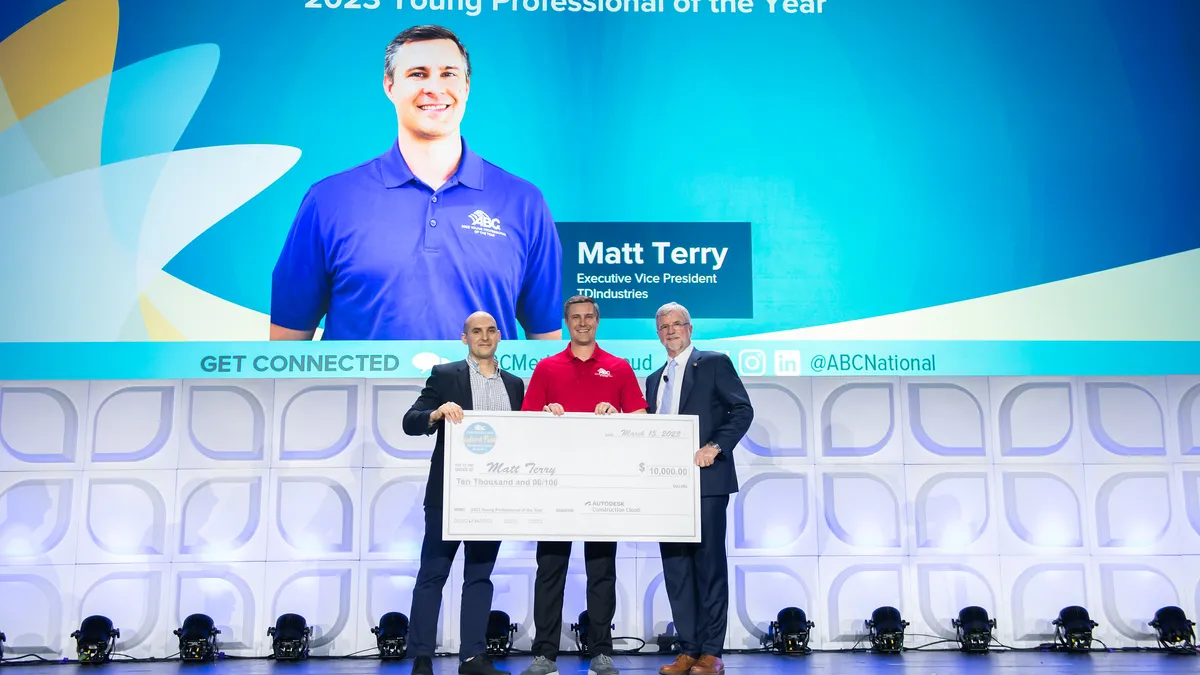Matt Terry introduces himself by talking about his wife and two young sons before mentioning his career. He says he’s excited to think his boys, 8 and 10, will someday be working in construction like him.
An executive vice president of Dallas construction and special projects for Dallas-based TDIndustries, Terry was named Associated Builders and Contractors’ 2023 Young Professional of the Year on March 15. In addition to his role at the facilities services and mechanical construction company — which focuses on projects like data centers and life science buildings — Terry, 40, works with the Construction Education Foundation, a local trade school in north Texas.
Here, Terry talks with Construction Dive about capturing data to make informed decisions, the jobsite of the future and taking into account total worker health.
The following has been edited for brevity and clarity.
CONSTRUCTION DIVE: You started with TDIndustries 15 years ago. What has changed since then? Where do you see construction 15 years from now?
MATT TERRY: When I think about joining TD in 2008, the first thing that comes to mind for me is safety. In 2007, our safety focus was primarily around physical safety: “Are you coming home the way that you went to work today?”
Now, there is much more of an emphasis in the industry and at TDIndustries on total human health. It's not just the physical safety that I go home without a physical injury, but creating a workplace of psychological safety, of emotional safety, of mental safety. So, that's been a big shift in a very positive and encouraging way that we've seen develop.
There also is a much larger emphasis today on our data strategy than 15 years ago, and I don't see that changing or slowing down. I think that trajectory is just going continue to move up, and even quicker than it has over the last 15 years. That's going to drive us to be able to deliver buildings much differently. It's going to allow us to use this data to make more informed decisions to drive a lot more prefabrication, to drive more modular construction solutions.
What is your advice for taking care of workers in a holistic manner?
One of the things that we're focusing on around the physical safety side for us are SIF precursors — serious injury and fatality precursor events. We're tracking near misses and looking at the potential of the near miss that could have resulted in a SIF. We're capturing significant data using SmartTagIt — an app from FactorLab — to better understand what activities are commonly occurring on our jobsites to prevent or eliminate the potential of a SIF on our projects.
For us, that's a big leading indicator that we're driving on the total human health side. A lot of what we talk about inside of our organization and with our leaders as we've gone through some mental health training with our leaders is around the connectedness and building that relationship within our company.
Where should contractors be looking to improve data capture?
The question is where are we not collecting data? In other words, the more data we're able to capture, the more we can analyze and make better decisions using it.
We have a significant data strategy around our safety metrics. So, all of our pre-test safety plans are recorded through SmartTagIt. We're able to go in and evaluate and score our pre-test safety plans and give quantitative and qualitative feedback to our field leaders on the effectiveness of their safety planning.
What’s the biggest challenge facing construction right now? What can be done about it?
I think it's the age-old opportunity and challenge that's facing us: How do we attract the best talent, and how do we develop that talent?
When we widen the horizon and broaden our search, we're going to be able to reach more people. We're going to be able to increase the diversity within the industry.
Ultimately we have to expand the ponds that we're fishing in, so to speak, so that we can more critically engage many different talent pipelines that are out there. I think it requires that as an industry, we invest in education, particularly earlier on, to get much earlier into the education life cycle.
It's no longer waiting until folks are coming out of high school, but it's getting into the high schools. It's getting into vocational programs, it's getting into middle schools, even.














